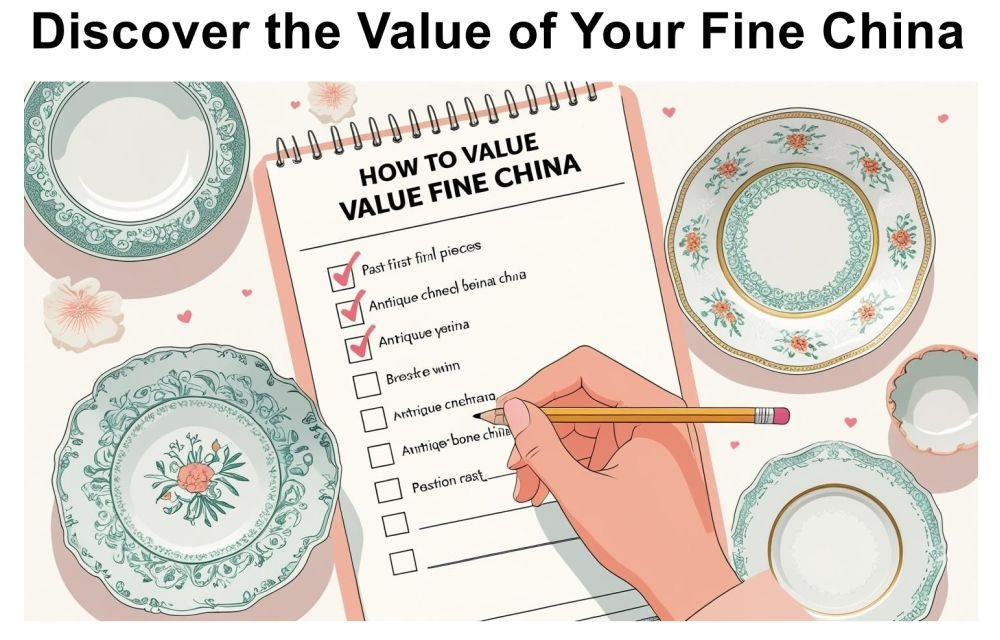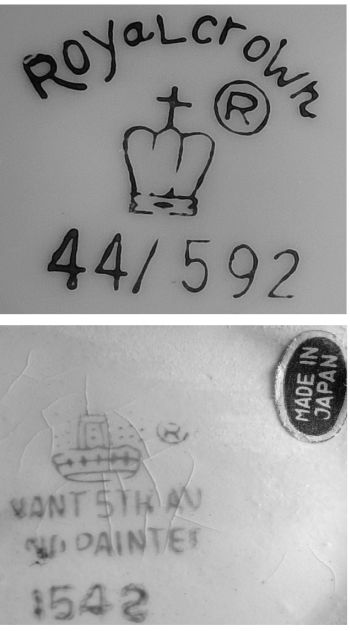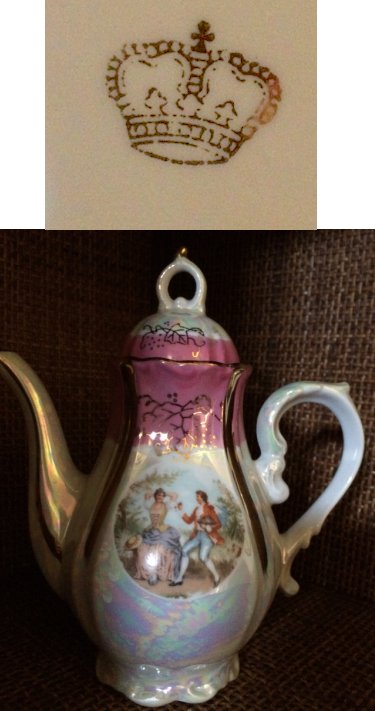Mystery 'Crown' Pottery Mark - {Editor says 'Arnart China' of Japan}
by Greg
(US)

Mystery 'Crown' Pottery Mark - {Editor says 'Arnart China' of Japan}
Mystery 'Crown' Pottery Mark Query - {Editor says 'Arnart China' of Japan}:- I have had a set of Demitasse 6, with creamer, sugar and tea pot for almost 20 years and tried to find the maker. I doubt it's real old, because it has a "R" in a circle for registered.
Here is a picture.
Many thanks in advance - hoping for a good result!
Greg
======================================
Reply from Peter (admin) below - just scroll down
HOW I MADE MONEY FROM BITS & BOBS OF OLD CHINA

.....more |
Reply by Peter (admin)
To:- Mystery 'Crown' Pottery Mark - {Editor says 'Arnart China' of Japan} Query
Hi Greg
Thanks for your excellent query! This really is one I can get my teeth into.
After 20 years of mystery and suspense I can finally shed light on your china conundrum. Always glad to be of help to my valuable visitors whenever humanly possible...
The mark shown is one of the 'crown' type pottery mark variations known to be used by a company called "Arnart Creations" (1953 until 2001).
Associated with the influx of cheap Japanese imports post-war (ie before the days when Japanese manufacturing was associated with the highest of high quality industry - cars and electronics etc), Arnart were trading on the edge of being described by some observers as 'fakesters'.
They changed their name in 1957 to "5th Avenue" after securing US based offices, and stopped using a printed stamped 'made in Japan' pottery mark, opting instead for a removable 'made in Japan' sticker (which, surprise, surprise, often got somehow rapidly removed!). As far as I am aware, despite the new labeling, the wares were still cheap mass produced import reproductions, all fairly recently made (since 1950 in contrast to 1750).
Arnart often used brand names such as 'Royal Chintz', designed to be very Western or English-looking pottery marks. Some people describe their wares as 'fake tat', but I always shy away from such a description because there is still the skill of the artisan to be considered. It is not the fault of the artisan what the marketeers decide to do with the products they make. It is not as if they are trying to forge bank notes or anything like that!
It is the ebay sellers who try to pass off wares such as Arnart as something they are not who are the most offensive to me.
In the case of Arnart, the wares are decent enough looking, although I have never handled any with my own hands.
The other thing to look out for with Arnart China, apart from the reproduction china tea sets, are the reproduction ('fake') Hummel figurines.
During the mid 1950's, Arnart decided to go into the figurine business. They were highly 'influenced' by the German Goebel company who very successfully make the Hummel collectibles.
Arnart employed German designer Erich Stauffer who by some accounts never had any connection with Hummel whatsoever. Other accounts also catagorically refute the fact that these Arnart figurines were ever made by German firm 'Kalk' based in Eisenberg, Thuringia - a story which somehow began to mysteriously circulate. It seems safe to assume these Erich Stauffer figurines were mass produced imports from Japan in the days before Japan became an esteemed and high quality industrial nation.
Actually, this makes the Arnart wares something of historical interest in themselves - as they represent to future generations an interesting snippet of 20th century history.
If I were an ebay powerseller, I would be promoting Arnart wares, not by trying to pass them off as European fine china, but as highly collectible wares of the future.
The only problem with this type of selling is Arnart seem to be still at it, which isn't good form for the collector of bygone rarities.
Trading as 'Arnart Imports Inc.' and based in 230 Fifth Avenue, they went about the business in 2000 - 2004 of discontinuing many old marks and withdrawing some registrations. There was quite a tangle of marks which were similar to famous makers - such as the 'Porzellanmanufaktur Kalk' crossed feathered arrows, the beehive variations etc etc.
Other Arnart pottery marks which are quite widely distributed and you may come across frequently are:- 'Royal Crown' ware, 'Royal Carlton' ware and 'ArMark'.
Some commentators say there must be some connection between Arnart and HOMCO due to the similarity of the decoration marks and the molds. This is outside my field of interest, so I don't know.
What I am interested in is allowing my visitors to use my pages as a means to more easily spot and identify the real quality fine china and porcelain makers and be able to spot the pottery marks which are associated with 'marketing trickery'.
The reason I appreciate Greg's query so much, and have spent so much time and effort writing it up is because Arnart are a very big player in the influx of 'repro' china (especially into the US). They must have had a big and skilled operation in order to make the type of wares they were exporting and it would be a difficult business to operate. Therefore, there could not have been that many big repro players around.
Keep a look out for fine china wares which are marked with any of the pottery marks described above, especially if they are being 'passed off' as 'European' in origin.
I am so glad to be of service in solving 20 year old mysteries for my visitors!
I've written a page especially to help visitors research their wares:
Thanks again Greg, I enjoyed answering that!
Best regards,
Peter (admin)
p.s. The following page is a 'must see' if you are researching fine china - for value and identification:-
Researching the identity and value of antique and vintage fine china.
Please post comments below which you think might be helpful……
Inherited a china set?... Download my free 7-point checklist to instantly assess its potential value.






